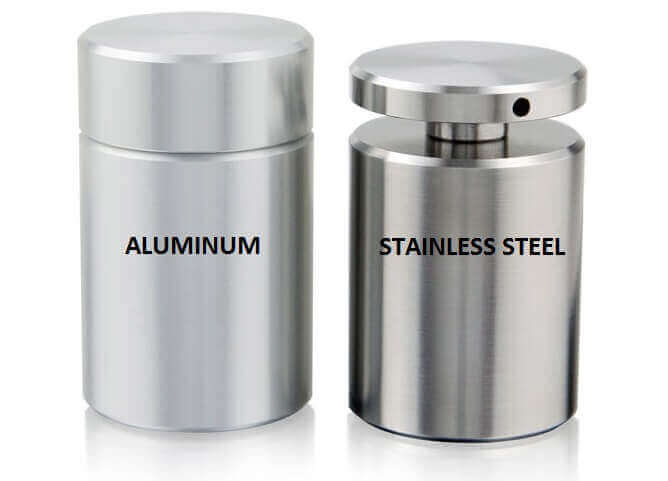What is aluminum and what is it used for?
Aluminum is commonly used metal for several applications. It is the third-most-common element on the planet. It has such a wide range of applications, from aluminum foil to jet engines. It is relatively inexpensive, light-weight, and strong. It can also easily combine with other materials making it a very versatile material. It is a good conductor of electricity but is resistant to heat, an important property for several applications. It doesn’t rust but it combines with oxygen to form aluminum oxide if you leave it exposed to air. It has a melting point of 660 C.
Most applications use alloys of aluminum. That means aluminum combines with other metals to form an alloy that has enhanced properties. An allow might be stronger or it can have a higher melting point than the individual elements. More than one metal can be combined with aluminum to form an alloy. The most common metals used with aluminum are copper, boron, magnesium, lithium, zinc, and silicon.
Aluminum can also be used as a composite material where it is combined with other materials but they retain their original properties. The materials do not chemical reach with one another. Aluminum can act as the matrix material which can be combined with other materials to make composite which generally is an extremely strong and durable material. Most of the aluminum applications in electronics and aerospace use composite materials. Aluminum can be combined with copper to increase its melting point, the combined product is ideal for use in car engines. For food packaging applications, there is a need for strength but also conformability of shape. For the purpose, aluminum is combined with magnesium.
What is stainless steel and what is it used for?
Stainless steel is an alloy of iron and other elements such as carbon, iron ore, chromium, nickel, and other additives. Its primary characteristics is that is resistant to corrosion compared to plain steel. The additives provide it with resistant properties by forming a reflective layer on the surface. The ratio of stainless steel with other additives depends on the type of end product required. These different ratios of stainless steel are referred to as the grade of stainless steel.
Apart from non-corrosive and rust-resistant, stainless steel is also a very strong material. In the transportation industry, it is used for smaller structural components in airplanes. It is also used to make certain shipping containers. It offers the advantage of being very easy to clean and maintain making it ideal to transport chemicals and food products. Depending on the grade of stainless steel, the melting point is typically around 1400 C. It is a recyclable product, which makes it environmentally friendly material.
Another very common application of stainless steel is medical technology. It is used on a variety of applications in the industry such as MRI machines, operation tables, modular walls, utensils, and more. It is also easy to sterilize and is a low maintenance material. The aesthetics of stainless steel has made a common used on jewelry and watches. It offers a shiny, sleek, and stain-resistant surface.
What are the difference between stainless and aluminum?
Strength
Although stainless steel and aluminum are both strong materials, stainless less is much stronger compared to aluminum. However, aluminum is lighter so it does have a better strength to weight ratio. In applications where both strength and light-weight properties are required, aluminum is a better choice. Aluminum is about one third in weight to stainless steel. For applications on skyscrapers and airplanes, weight is extremely critical but if strength is the primary requirement, then stainless steel is a better choice.
Cost
Depending on the grade of stainless steel, it is typically more expensive than aluminum.
The price of either material fluctuates depending on the cost of raw material and global demand. Other factors such as fuel price and availability of iron and bauxite ore also play a role in the price of these materials.
Food Safety
Another difference between stainless steel and aluminum is their ability to be used on food-related applications. Stainless steel is less reactive to foods, therefore is more commonly used in such applications.
Thermal Conductivity
Aluminum is a better conductor of heat compared to stainless steel. This is one of the primary reasons why aluminum is used for air conditioners and car radiators, which need higher thermal conductivity.
Welding
Stainless steel is easier to weld compared to aluminum.
Corrosion Resistance
Aluminum has an advantage over stainless steel when it comes to corrosion resistance. Aluminum doesn’t require any coating or treatment for its corrosion resistance. The natural oxide layer acts as a barrier to corrosion. On the other hand, stainless steel does require a coating of paint for protection from corrosion. The corrosion resistance properties of aluminum can be further enhanced by anodizing it or by providing a powder coating, painting, or media blasting.
Electrical Conductivity
Stainless steel is a poor conductor of electricity. That means it cannot be used for certain electronics applications that require this electrical conductivity. For applications such as high-voltage power lines, aluminum is used.
Weight
The reason why stainless steel is heavier is because of its higher carbon content. The grade of stainless steel with higher carbon content weight more compared to other grades. Even the lightest grade of stainless steel is heavier than the typical aluminum material. There are certain applications where stainless steel has the advantage of being a heavier material. Any application that requires a material that is durable, not easy to bend, warp or deform, stainless steel is used. For example, in watches, stainless steel is commonly used as the application requires durability and strength.




